Carrying Cases of Field Cameras, ~1860-1930
 Since
field cameras were meant to be toted around, they often came complete
with a carrying case. Even when sold without a lens, the case was
usually supplied.
Since
field cameras were meant to be toted around, they often came complete
with a carrying case. Even when sold without a lens, the case was
usually supplied.
Wood
The most common case material in the 1880's to the early 1890's was wood. It is durable and protects the camera as well as any case can. The wood used was either pine or white wood and approximately 5/8" thick. The wood must have been well seasoned, since little warpage is generally found. Try making something out of modern 5/8" pine and you will have so much twisting you may as well not even try to make anything.
Cases from different manufacturers can usually be identified from their construction. E.&H.T. Anthony wood cases had box joints, were thinly varnished, and often had metal guides or corner guards and leather handles held on by metal hardware.
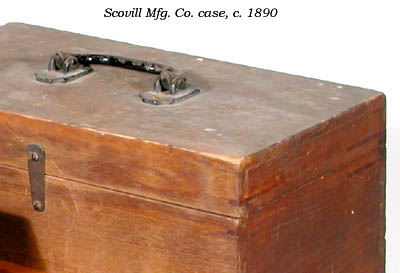
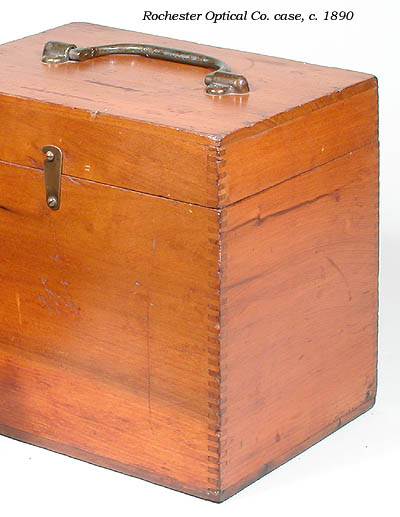 Rochester
Optical Co. wood cases have box joints, heavier varnish than Anthony
cases, and are the easiest to identify since they are normally stamped
with the manufacturer.
Rochester
Optical Co. wood cases have box joints, heavier varnish than Anthony
cases, and are the easiest to identify since they are normally stamped
with the manufacturer.
Canvas
Another common case of the 1880's-1910's was constructed of thick (~1/8" thick) cardboard covered on the outside with canvas and covered on the inside with cotton flannel, For some cases, the top was hinged (the hinge consisting only of flannel covered by canvas). Other cases had pull-off tops. Whether hinged or pull-off, the tops were secured with one or two leather belts or straps extending all the way around the case, and usually sewn into the canvas at two or more spots on the way around.
For some manufacturers, e.g., Blair (Blair Tourograph Co., Blair Tourograph & Dry Plate Co., Blair Camera Co.) and Eastman (Eastman Dry Plate & Film Co., The Eastman Co., Eastman Kodak Co.), all their cameras seem to have had canvas cases, regardless of the price of the camera. For other manufacturers, e.g., Scovill (Scovill Mfg. Co., American Optical Co., The Scovill & Adams Co.), Anthony (E. & H.T. Anthony, Anthony & Scovill Co.), and Rochester (Rochester Optical Co., Rochester Camera Mfg. Co., Rochester Camera Co., Rochester Camera & Supply Co., Rochester Optical & Camera Co.), canvas cases were reserved for their more expensive cameras, while inexpensive cameras had wooden carrying cases.
Wooden cases are much more plentiful at the present than are canvas cases - probably there have been roughtly 8 wooden cases for every canvas case on eBay during the 30 years I have been monitoring view cameras there. Yes, there were probably more wooden cases manufactured because there were more inexpensive amateur cameras sold than expensive ones. But, it is also evident at this time that a canvas-covered cardboard case, regardless of the relative price of the camera within it, is also much more fragile than the wooden version of a carrying case. This means that canvas cases are rather rare, and, even when present with a camera, are likely to have condition issues - loose or missing canvas (also to a lesser extent flannel), warpage and discoloration due to contact with water, rotting of the leather straps, and wear, tearing and disconnection of canvas hinges.
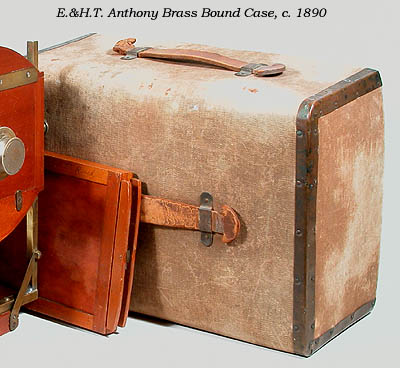 E.&H.T.
Anthony produced a brass bound canvas case which was almost as robust as
a wooden case.
E.&H.T.
Anthony produced a brass bound canvas case which was almost as robust as
a wooden case.
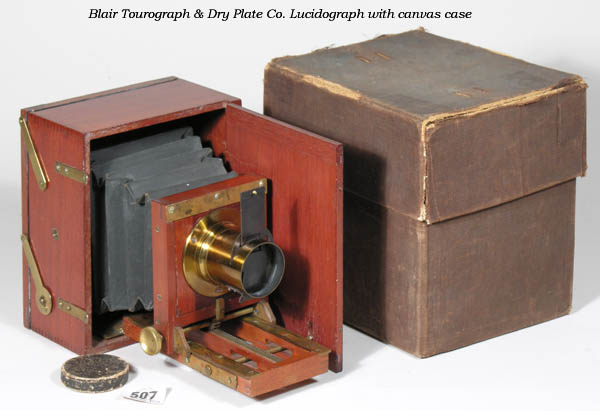 Oddly
enough, canvas-covered cardboard cases of the 1880's were found with
expensive cameras, like those of the American Optical Co. and Blair
Tourograph and Dry Plate Co.
Oddly
enough, canvas-covered cardboard cases of the 1880's were found with
expensive cameras, like those of the American Optical Co. and Blair
Tourograph and Dry Plate Co.
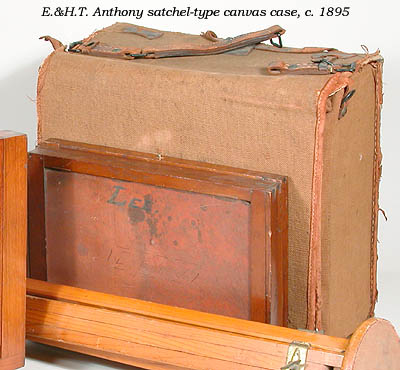 In
the 1890's canvas-covered cardboard cases became commonplace.
In
the 1890's canvas-covered cardboard cases became commonplace.
There were satchel-looking types.
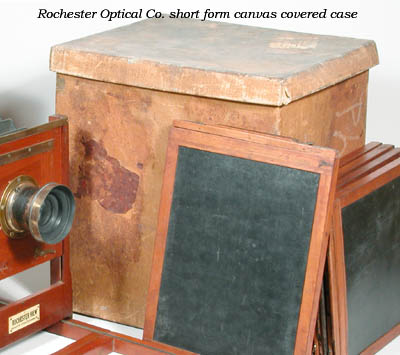 There
were short canvas cases that could stow the camera and one or two
plateholders.
There
were short canvas cases that could stow the camera and one or two
plateholders.
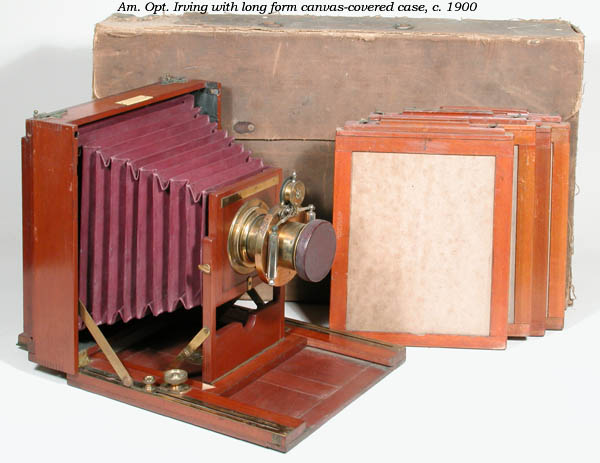 Sometimes
a long version was also available, with room to the side of the camera
for up to 6 plateholders, and even room for a tripod in some of them.
Sometimes
a long version was also available, with room to the side of the camera
for up to 6 plateholders, and even room for a tripod in some of them.
Canvas cases are relatively fragile, subject to warping and disintegrating when wet, and, for cases having hinged tops, tearing and possible separation. I occasionally try to minimize current damage and try to prevent future damage. Some examples of damage and treatment are shown on a canvas case treatment web page.
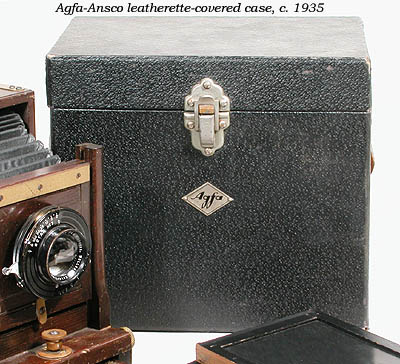 Later
Cases
Later
Cases
In the 1920's and later, leatherette-covered wood or cardboard cases, or fiberboard cases were used.
